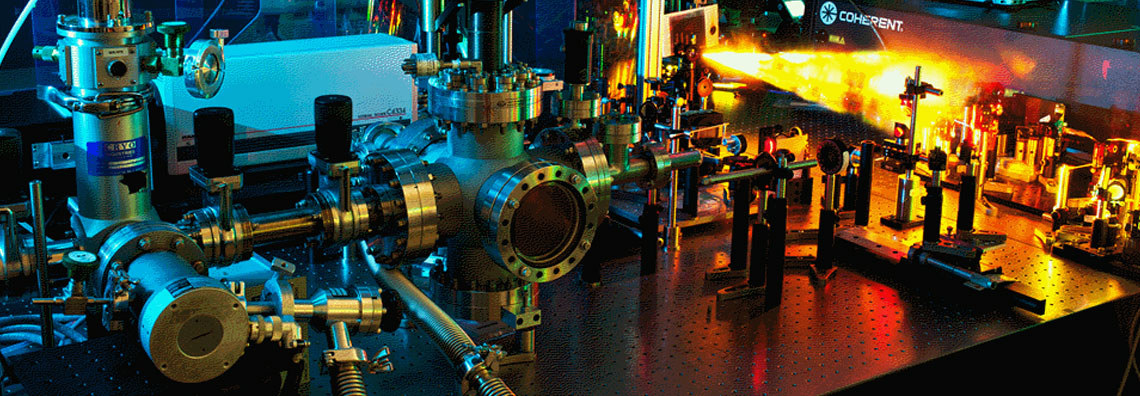Optics Research
Areas of Research:
- Advanced Materials
- Atomic Optics
- Biomedical Optics

- Fiber Optics
- Laser Cooling
- Laser Physics
- Lithography
- Nano-Photonics
- Nonlinear Optics
- Optics Education
- Optical Imaging
- Optical Sensors
- Optoelectronics
- Photonic Integrated Circuits
- Quantum Optics
- Spectroscopy
- Ultrafast Phenomena
Optics Research:
In elaboration of the importance of optics as an enabling technology, we think it is worthwhile to give a single simple example of the pervasiveness of optics/photonics in everyday life: e.g., the iPhone. A quick look shows multiple remarkably thin cameras (front and back) with amazingly good quality photos and movies, and a beautiful, illuminated viewing screen (of multiple technologies, including liquid crystals, organic light emitting diodes (OLEDs), quantum dots, micro-LEDs). Also, whenever a phone call is made or accepted, we all know that the information 3 is transmitted using optical fibers (of many varieties). This is also true of the information relayed from billions of computers around the world using the world-wide web, WWW (for good and for bad). What is often not recognized is that the internal electronics of the iPhone, computers, information storage/retrieval systems, etc., require highly sophisticated optics to produce the integrated chips. Advances in optical lithography enabled all of these and was the single foundational technology that drove most of the technological advances of the 20th century. And UNM/CHTM/OSE had a role in this advancement (e.g., still collecting royalties). The i-Phones of the future will surely have more lasers/optics internally: e.g., face recognition, image projection, or internal communication, which has already been required in the huge data centers around the world. For other examples, just think about the things you see and do every day from the grocery store to the ‘electronic’ (often optoelectronic) products you buy, to the lighting in your house, ubiquitous displays (on TVs, buildings, billboards,…), DVDs, laser pointers, health care, tattoo removal, surgery, cancer therapy, endoscopic imaging, eye imaging/coherence tomography, infrared cameras, temperature sensors, blood sensors (e.g., oximeter), remote sensing, TV remote, fiber sensors in bridges, etc. One can identify many others.
These applications fit into nearly all aspects of the modern-world life and clearly into every traditional scientific, technological, academic, as well as industrial field. The interdisciplinary nature of the technologies involved allows faculty members from many different departments to participate. The OSE program provides a platform for collaboration, research, and academic study for these various optical technologies. -Eric W. Van Stryland, Founding Dean and Pegasus Professor Emeritus CREOL, The College of Optics & Photonics, 2021 OSE Academic Program Review Team Report.
The UNM Optical Science and Engineering program is a highly research active program with an extensive history of scholarly activity on the part of the faculty. These scholarly activities can be measured through many metrics; one such approach is to look at the publication and H-index. In both metrics, OSE shows the hallmarks of robust research activity with excellent scholarship.
The OSE faculty have also had a strong track record of fundraising. Grants received by the faculty in the program include those from DoD (AFOSR, ONR, AFRL and ARO), NSF, DARPA, DTRA, DoE, Sandia National Labs LDRDs, and LANL to name a few. The expenditure translates into support for the employment of research staff, post-doctoral researchers, and graduate research assistants. The ability to support such a large cohort of PhD students is directly the result of the funds raised. These funding levels have been sustained for the past decade.
OSE is strongly involved with all three major laboratories in New Mexico. Sandia National Labs, Los Alamos National Labs and the Air Force Research Laboratory are all closely linked with the OSE program. This includes the direct funding of OSE faculty research, the support of graduate students and sharing of research resources. SNL/LANL also jointly operate the Center for Integrated Nano Technology (CINT) user facility, which is heavily used by OSE faculty.
The OSE program is also closely involved with UNM centers such as the Center for High Technology Materials (CHTM) and the Center for Quantum Information and Control (CQUIC). In particular, the ties with CHTM are very strong with most of the ECE members of OSE and several P&A members housed at CHTM.
OSE Faculty Page with Members' Research Websites:
https://optics.unm.edu/people/index.html
